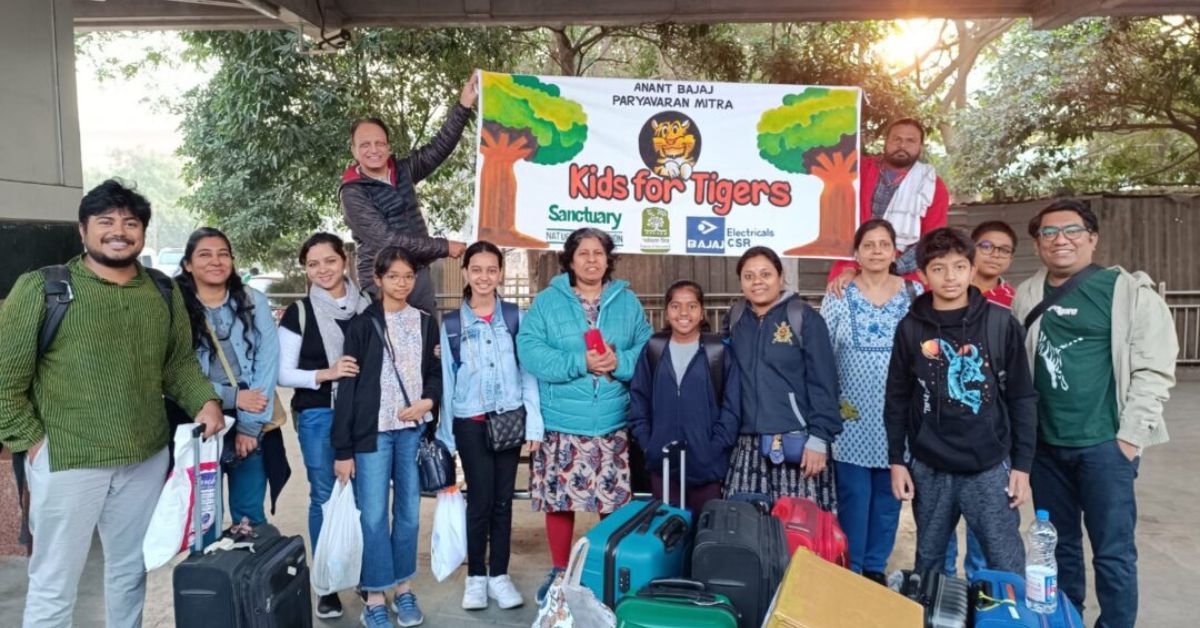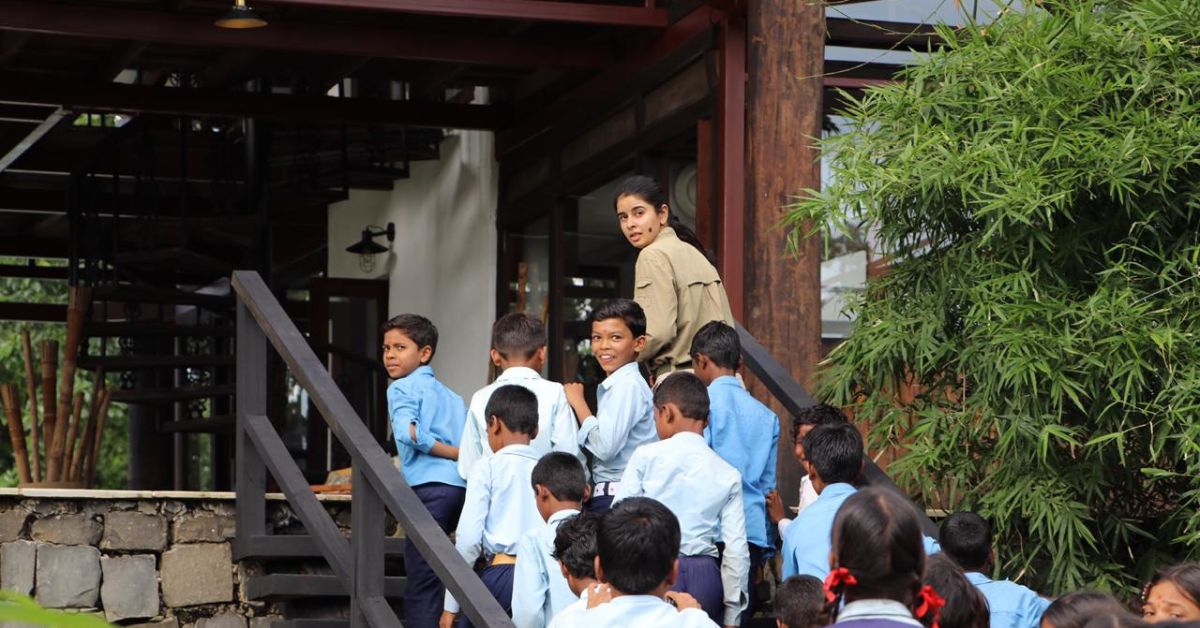How Are These Children Learning to Track Tigers and Rescue Snakes?
Feature image courtesy: Pugdundee Safaris
If your idea of wildlife education is limited to watching The Jungle Book on repeat or spotting pigeons on your balcony, it’s time for a wilder upgrade.
Across India, a new kind of classroom is emerging, one without blackboards or desks, but with paw prints, pugmarks, and possibilities.
From the muddy trails of Ranthambore to the rescue centres of Agra, several organisations are giving children the ultimate hands-on adventure: learning how to be real-life wildlife heroes.
And we’re not talking about a day out with binoculars. These are year-round, deep-dive programmes where children learn to track tigers, rescue snakes (ethically), clean animal habitats, and understand the delicate dance of ecosystems, all while building empathy and a fierce love for nature.
Here’s how three amazing initiatives — Kids for Tigers, Pugdundee Safaris’ Young Explorers, and Wildlife SOS — are grooming the next generation of conservationists.
1. Kids for Tigers: Growing young guardians of the wild
Started in 2000 by Sanctuary Nature Foundation, Kids for Tigers is an environmental‑education outreach programme that has reached over a million children in rural and urban India.
 Kids for Tigers is an environmental‑education outreach programme that has reached over a million children. Image courtesy: Kids for Tigers
Kids for Tigers is an environmental‑education outreach programme that has reached over a million children. Image courtesy: Kids for Tigers
It uses the tiger not just as another species to protect, but as a living metaphor for ecosystems, forests, rivers and climate. Children are taught that saving tigers helps preserve much more: water security, biodiversity and even climate stability.
The programme is structured across school grades: primary pupils (grades 1–2) receive introductory lessons on local flora and fauna; grades 3–5 explore interconnections within nature such as food chains and habitat adaptation; and older students (grades 6–8) confront themes like conservation necessity, threats and solutions.
Activities include nature walks, interactive workshops, tiger festivals, camps and city‑based presentations. Through these immersive experiences, many children emerge as Tiger Ambassadors — engaging peers, teachers and even policymakers to adopt wildlife‑friendly behaviours.
Kids for Tigers has official patronage from India’s Ministry of Environment, Forest and Climate Change, Project Tiger and numerous conservation partners. Beyond education, it also nurtures team building, ethics and curiosity: qualities essential for the next generation of conservationists.
2. Pugdundee Safaris Young Explorers / Naturalists: Safari education for kids
Pugdundee Safaris, a well‑known responsible tourism firm, offers Young Naturalist Training (YNAT) for children aged nine to sixteen. While this is tied to a wildlife holiday (a minimum four‑night stay at one of their lodges in reserves, such as Bandhavgarh, Kanha, Tadoba, Pench or Satpura), the programme provides a structured educational experience alongside guided safaris.
 Pugdundee Safaris offers Young Naturalist Training (YNAT) for children aged nine to sixteen. Image courtesy: Pugdundee Safaris
Pugdundee Safaris offers Young Naturalist Training (YNAT) for children aged nine to sixteen. Image courtesy: Pugdundee Safaris
Children join workshops led by trained naturalists, participate in at least four guided safari drives, and learn to observe flora and fauna with curiosity. The aim is to cultivate a lifelong appreciation for nature.
YNAT is offered complimentary with the safari stay, and though it is not a standalone school workshop, it provides urban children, in particular, with a direct and immersive connection to Indian wildlife in its natural habitat.
Through this exposure, youngsters learn ecosystem functioning, animal behaviour, spoor tracking, and the importance of responsible and ethical wildlife tourism. Though limited to those who can travel, Pugdundee’s model introduces children to conservation in the field, often inspiring future naturalists and biologists.
3. Wildlife SOS Education Initiatives: Awareness in schools and beyond
Wildlife SOS was founded in 1995 by Geeta Seshamani and Kartick Satyanarayan. Initially renowned for rescuing dancing bears and rehabilitating them, and the communities that once exploited them, the organisation has grown into one of South Asia’s largest wildlife NGOs. Its remit now includes elephant rescue, leopard conservation, habitat restoration, anti‑poaching operations and root cause awareness.
 Wildlife SOS conducts engaging, age‑appropriate presentations, case studies, rescue‑story sessions, and interactive features for schools. Image courtesy: Wildlife SOS
Wildlife SOS conducts engaging, age‑appropriate presentations, case studies, rescue‑story sessions, and interactive features for schools. Image courtesy: Wildlife SOS
Central to Wildlife SOS’s future‑oriented strategy is its Education Initiative. This programme is designed to fill an obvious gap: mainstream curricula often omit wildlife conservation and human‑wildlife coexistence.
WSOS conducts engaging, age‑appropriate presentations, case studies, rescue‑story sessions, and interactive features for schools, colleges and clubs across India. These sessions are customised by region. For example, focusing on leopards where human‑wildlife conflict is high can help pupils embrace coexistence and empathy.
Live demonstrations also extend to reptile awareness workshops in urban school settings (such as Delhi‑NCR), encouraging respectful and safe attitudes towards snakes, monitor lizards and other misunderstood urban fauna.
Through these programmes, children develop empathy, learn first‑aid basics for snakebites, and understand the impact of tourism practices like elephant rides.
Wildlife SOS also encourages volunteer engagement and visits to its rescue centres, where older teens and families can directly assist with environmental education, bear or elephant care, gardening and community outreach.
Why these programmes matter
These three approaches share a broader vision: children can be catalysts of change if given knowledge, access, and agency.
Kids for Tigers brings the ecosystem alive in classrooms and villages. Young Naturalist Training offers safari‑based immersion to turn awe into appreciation. And Wildlife SOS Education builds long‑term awareness and informed attitudes.
Together, these programmes emphasise that wildlife conservation is not just about rescue, it is about prevention, empathy, stewardship, ecosystem health and sustainable coexistence.
How parents, teachers and kids can join in
- Schools and teachers: To enrol in Kids for Tigers, schools can reach out via the Sanctuary Nature Foundation. Many city schools and tiger‑reserve‑adjacent institutions host annual ‘Tiger Fests’ and nature camps.
- Families interested in field learning: Book a wildlife holiday with Pugdundee Safaris at flagship reserves like Pench, Kanha or Tadoba; ask about the Young Naturalist Training addition. No prior wildlife exposure is needed; the programme is included with the stay.
- Institutions seeking workshops: If you represent a school, club or college, contact Wildlife SOS (via their website) to request the Education Initiative for your region. They offer virtual sessions (Delhi, Bengaluru and national rollout) and live reptile awareness workshops in urban schools.
- Volunteers and older students: Wildlife SOS also invites volunteers to assist in rescue centres. While direct animal contact is not part of the programme, volunteers support animal welfare tasks, habitat enrichment and environmental education efforts.
By participating in any of these, children gain knowledge, empathy and agency. They return home not just inspired, but motivated to be voices for their wild companions.
In a world increasingly dominated by screens, concrete, and climate anxiety, these programmes offer something rare: an invitation to connect, to care, and to act. They don’t just teach facts about wildlife; they build relationships with it.
So, if you know a child (or secretly are one) who’s ever marvelled at a honeybee, worried about a wounded dog, or gasped at the sight of an elephant, now’s the time to turn that spark into stewardship.
News